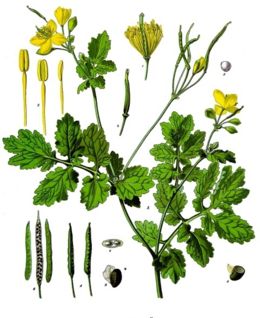Greater celandine

Modern Homoeopathy
Monthly E-Newsletter February 2008
CHELIDONIUM MAJUS - A GENUS EPIDEMICUS IN HEPATITIS A
by
Dr. Poonam Godbole
Hepatitis A which is also called as viral hepatitis is caused by the hepatitis A virus and is the most common type of hepatitis. It is a highly contagious disease which mainly affects the liver. This disease is generally categorized under water-borne and food-borne diseases which results in mild to severe affection. The symptoms of hepatitis A include an abrupt onset of fever, malaise, loss of appetite, nausea, vomiting, abdominal pain, dark-coloured urine and icterus ( yellowish colour of the skin and whites of the eyes).
The concept of using a single remedy which will act as a prophylactic during an epidemic is very common in the allopathic line of treatment. Though homoeopathy is a science in which we believe in individuality at the level of the person as well as the drug, there are some homoeopathic medicines that can work as prophylactic medicines in case of a particular disease. Genus Epidemicus is the word formulated by Dr. Hahnemann which indicates the homoeopathic remedy that is similar to the totality of symptoms found in majority of patients suffering in an epidemic disease and which if given to the patient before the onset of the disease prevents the epidemic disease or when given during the disease cures the patient. There has been a reference for the same in the Organon in the aphorisms 101-104. Totality of symptoms in the epidemic disease consists of the common symptoms of disease as well as uncommon symptoms found in a majority of patients suffering from the epidemic disease.
According to the surveys by the homoeopathic research institutes, Chelidonium had acted as a genus epidemicus to the hepatitis A epidemics in the past. So let’s review the role of Chelidonium in the cases of Hepatitis A.
|
Greater celandine |
|
|
Introduction: Chelidonium is also called as Greater Celandine, Garden Celandine, or Tetterwort. It is a yellow flowering plant in the poppy family.
Pharmacology: The whole plant is toxic in moderate doses as it contains a range of isoquinoline alkaloids. There are numerous therapeutic uses when the plant is used in correct dosage. The main alkaloid present in the herb and root is coptisine. The other contents include chelidonine and sanguinarine. It acts as a mild analgesic and antimicrobial.
URINE: Highly concentrated urine, dark coloured, yellow colour, frequent urge to urinate.
A primer of materia medica for practitioners of Homoeopathy by T.F. Allen
Lectures on Homoeopathic Materia Medica by J.T. Kent
http://en.wikipedia.org/wiki/Greater_celandine